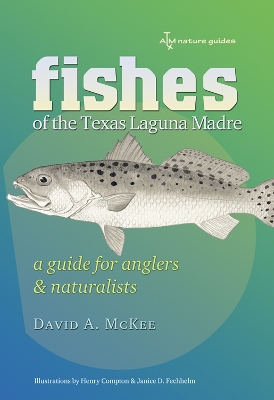Gulf Coast Books, sponsored by Texas A&M University-Corpus Christi
2 total works
Anglers treasure the Laguna Madre, a shallow lagoon resting along one hundred miles of the South Texas coast that offers some of the best fishing in the Gulf of Mexico. Its lush environment of seagrass meadows, tidal flats, submerged rock, jetties, worm reefs, mangroves, oyster beds, and open bays provides shelter, food, and nursery grounds for more than 100 kinds of fish, and in its upper portion, many popular game fish are at record levels.In ""Fishes of the Texas Laguna Madre"", longtime angler and fish biologist David A. McKee taps into a lifetime of fishing and studying the lagoon to give us an expert's guide to this estuary and the fish that live there.This book covers the natural history of the ""Mother Lagoon"" and provides information on the characteristics, life histories, ranges, and habits of the fish species found in this hypersaline environment. For some, and especially the ""Big 5"" coastal sportfish (spotted seatrout, red drum, black drum, sheepshead, and southern flounder), McKee offers additional notes on angling techniques, personal observations, record catches, and regulations. He also raises important conservation issues for boaters and anglers to keep in mind while enjoying this unusual ecosystem.Visitor contact information (including the location of boat docks, boat ramps, and piers) rounds out the text, along with three maps of the Laguna Madre. Excellent black-and-white drawings of the fish, the majority by the late Henry ""Hank"" Compton, are featured throughout.""Fishes of the Texas Laguna Madre"" is for novices and ""lagunatics"" alike. It will be an invaluable guide for anglers and naturalists; canoers, kayakers, and boaters; students and teachers of fishery science; and anyone who lives near or has an interest in this unique and expansive body of water.
The cold, stygian dark of the extreme sea depths is home to some of our planet's strangest creatures. Even their names evoke a science fiction adventure: dragonfishes, greeneyes, viperfishes, mirrorbellies, lanternfishes. Marine biologist Henry "Hank" Compton (1928-2005) of the Texas Parks and Wildlife Department's Rockport Marine Lab was present on some of the earliest Gulf of Mexico cruises on which these fishes were collected for the first time in Texas waters.
Upon returning, Compton would retire to the darkroom he had constructed beneath a stairwell at the lab and photograph the specimens. A talented artist, Compton then painted watercolors based on his photographs. He allowed free rein to both his scientific judgment and his artistic vision as he constructed representations of how the specimens might have appeared in the crushing pressure of their alien environment.
Compton dubbed the series of deep-water paintings "Fire in the Sea" because of the shimmering bioluminescence common to these deep-water species. Then, along with taxonomic descriptions, he drafted fanciful narratives to accompany the paintings: quirky, humorous, and sometimes cryptic stories of the fishes in their unreachable habitat.
Professor, researcher, and author David A. McKee has taken Compton's work, discovered in cardboard boxes following his death, and, along with others, provided chapters on bioluminescence, life in the deep, taxonomic arrangement, and life history information.
Upon returning, Compton would retire to the darkroom he had constructed beneath a stairwell at the lab and photograph the specimens. A talented artist, Compton then painted watercolors based on his photographs. He allowed free rein to both his scientific judgment and his artistic vision as he constructed representations of how the specimens might have appeared in the crushing pressure of their alien environment.
Compton dubbed the series of deep-water paintings "Fire in the Sea" because of the shimmering bioluminescence common to these deep-water species. Then, along with taxonomic descriptions, he drafted fanciful narratives to accompany the paintings: quirky, humorous, and sometimes cryptic stories of the fishes in their unreachable habitat.
Professor, researcher, and author David A. McKee has taken Compton's work, discovered in cardboard boxes following his death, and, along with others, provided chapters on bioluminescence, life in the deep, taxonomic arrangement, and life history information.

